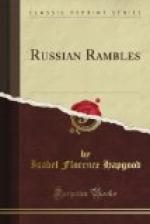Beyond this lie the heights, on which stand the fortress and the Catacombs Monastery. Opposite the arsenal opens the “Holy Gate;” all Russian monasteries seem to have a holy gate. “The wall, fourteen feet in height, and more in some places, surrounding the principal court, was built by Hetman Mazeppa,” says the local guide-book. Thus promptly did we come upon traces of that dashing Kazak chieftain, who would seem, judging from the solid silver tombs for saints, the churches, academy, and many other offerings of that nature in Kieff alone, to have spent the intervals between his deeds of outrageous treachery and immorality in acts of ostentatious piety. In fact, his piety had an object, as piety of that rampant variety usually has. He meditated betraying Little Russia into the power of Poland; and knowing well how heartily the Little Russians detested the Poles because of the submission to the Pope of Rome in those Greek churches designated as Uniates, he sought to soothe their suspicions and allay their fears by this display of attachment to the national church. His vaingloriousness was shown by his habit of having his coat of arms placed on bells, ikonostasi,* and windows of the churches he built. In one case, he caused his portrait to be inserted in the holy door of the ikonostas,—a very improper procedure,—where it remained until the middle of the last century. Highly colored frescoes of the special monastery saints and of historical incidents adorned the wall outside the holy gate. Inside, we found a monk presiding over a table, on which stood the image of the saint of the day, a platter covered with a cross-adorned cloth, for offerings, and various objects of piety for sale.
* Image screens.
The first thing which struck us, as we entered the great court, was the peculiar South Russian taste for filling in the line of roof between the numerous domes with curving pediments and tapering turned-wood spirelets surmounted by golden stars and winged seraphs’ heads surrounded by rays. The effect of so many points of gold against the white of the walls, combined with the gold of the crosses, the high tints of the external frescoes, and the gold of the cupolas, is very brilliant, no doubt; but it is confusing, and constitutes what, for want of a better word, I must call a Byzantine-rococo style of architecture.




